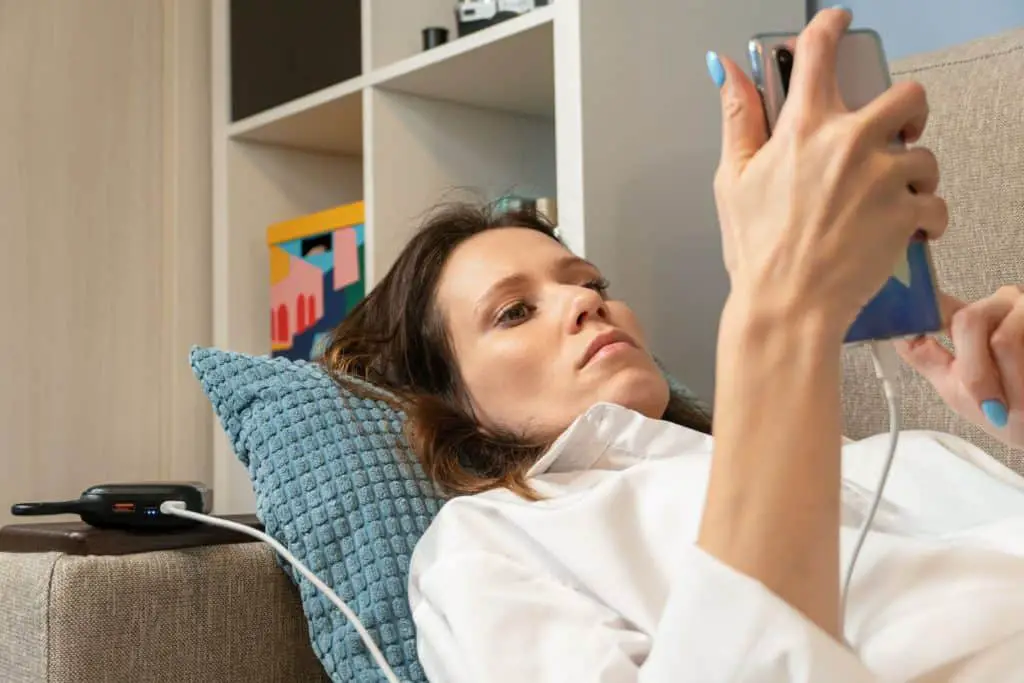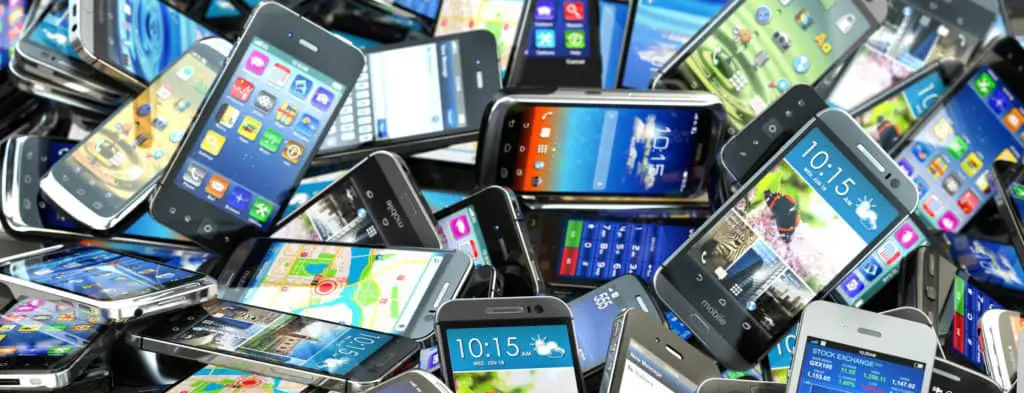It's frustrating! You're right in the middle of doing something important on your smartphone when the low battery warning flashes at you. We're always searching for a cord and charger or battery pack. The problem seems to get worse the older your phone gets. So, what is the average smartphone battery life expectancy?
Smartphone battery life expectancy is 2-3 years, with manufacturers considering end-of-life at a 20% capacity loss. Cell phones last on average 22 hours, 16 minutes while in use, and 85-186 hours in full standby mode. Charging habits and device care are essential factors.
Here are 15 familiar, frequently-asked questions with answers to help you maximize your smartphone battery. Further down, there's also a table of 9 top smartphone brands with average battery life performance, including light use, heavy use, average daily performance, and battery efficiency.
15 Common Smartphone Battery Questions
Your smartphone battery is a brilliantly designed and carefully balanced set of chemical reactions.
Most FAQs often dig too deep into the science and technology failing to provide concrete explanations and actionable advice to keep your battery healthy and your smartphone charged.
We referenced dozens of articles and a few white papers about Lithium-polymer batteries, which are still the primary type of power cell in smartphones. Let's guide you through the most common questions in three categories: recharging, hardware, and power consumption.
Recharging Habits
Most user questions center around charging, discharging, and recharging your smartphone battery.
Does frequent charging damage a phone battery?
Frequent charging does not damage a phone battery. Current smartphone batteries are best maintained between an 80% and 20% power level. Shorter charging cycles when it's convenient are ideal to avoid heat. Avoid plugging in too frequently where damage to the charging connector may occur.
How do I keep my battery at 100%?
To keep a smartphone battery at 100% charge, users must remain attached to a charger or battery pack. A charging controller will monitor the power level just below 100%. It will turn on to add power at a predefined level. Keeping a battery at 100% stresses the materials reducing lifespan.
Stick to the 80-20 principle mentioned earlier to give your battery its best life.
At what percentage should I charge my phone?
Charge a smartphone when its power level percentage is between 20 and 40. Planning to plug in between these levels provides the longest battery lifespan for mobile phones. Recharging around the 20% to 40% range rapidly returns the battery to a dependable 80% level.

Is it bad to leave your phone charging all night?
Leaving a phone charging all night is bad over the long term. Modern smartphones have an onboard charging controller that cycles on and off to prevent overcharging. Staying plugged in overnight adds wear to this mechanism and the battery over many hours daily, reducing total lifespan.
A great practice is to stop using your smartphone 1-2 hours before bedtime and plugin it in to charge. When you go to bed, unplug it.
You can charge it again in the morning, if needed, before starting your day.
Is it bad to charge your phone multiple times a day?
Charging your phone multiple times a day is an ideal pattern for maximizing your smartphone and battery life expectancy. Shorter charge cycles reduce heat build-up leading to bad smartphone hardware performance over the long term. Maintaining a power level between 80% and 20% is a good guideline.
The downside to this strategy is that you'll need a charging cord, power adapter, or external battery pack on hand more frequently. Plan ahead when you expect to leave home, work, or while you're in the car.
Is it bad to charge your phone to 100%?
It is not bad to charge your phone to 100%. Once the battery nears a 100% charge, the in-built charging controller will prevent overcharging by cycling power on and off. Aim to unplug your phone between an 80% and 90% power level. This is key to maximize smartphone life expectancy.
Does temperature affect charging speed?
Temperature does affect the charging speed of a smartphone battery. Recharge your phone between 0-45°C or 32-113°F. Connecting outside these ranges can significantly slow the storage of electricity into the battery cells. Smartphone charging speed is quickest when powered between 15-35°C or 59-95°F.

Is it ok to use a mobile while charging?
Using a mobile phone while plugged in and charging is ok, but should be done sparingly. The excess heat produced by the screen, radio transmitters, and body heat raise the battery temperature. Higher temperatures slow the charging process and reduce smartphone battery life expectancy.
It's best to take a screens break and allow your smartphone to charge to 80-90% before unplugging it and using it again.
Battery Hardware
Batteries come in many sizes, shapes, capacities, and chemical variations depending on the smartphone manufacturer's designs.
The number of questions is equally as varied, but here are some of the more common ones.
How long do unused phone batteries last?
Unused phone batteries will last around 10 years with a moderate functional loss. A completely disconnected phone battery will last the longest in storage. Maximize shelf life by storing unused batteries with a half charge and at cooler room temperatures: 15°C or 59°F.

How can I store my phone battery when not in use?
Charge or discharge the phone battery to 40-50%.
Remove the battery from the phone if possible.
Place the battery or smartphone in a plastic bag or container.
Add a silicone gel pack to control humidity.
Seal the storage container.
When it's time to re-insert and/or begin using the smartphone battery again, charge the device to 80-90% before the first use, preferably while the phone is off.
How can I make my battery 100% again?
Phone batteries begin to degrade as soon as they're manufactured. The chemical reactions that produce power are not perfectly efficient. After a couple of years of recharging, there is no way to make the battery 100% again. An old battery should be recycled and replaced with a newly-produced unit.
How do I keep my phone battery healthy?
Aim to maintain a charge between 20% and 80%.
Plugin for shorter charges throughout the day when needed.
Don't charge overnight.
Operate the phone at room temperatures: 15-35°C or 59-95°F.
Go without a case if you can.
Worry less about optimizing for battery health.
Remember, you'll likely upgrade or replace your smartphone before the battery becomes the primary problem.
Power Consumption
Most users think that battery drain is just a hardware problem. They blame the manufacturer for cost-cutting by using a smaller battery or cheaper battery materials.
In addition to charging habits, the apps and tasks a smartphone owner uses have a noticeable impact on battery life.
Why is my phone battery draining so fast?
The primary causes of a fast-draining phone battery are the
On-time and brightness of display or screen.
Amount of cellular communication, e.g., calls & data use.
Graphics and video processing, e.g., games & face time/video calls.
Background apps, e.g., location services, live wallpapers, widgets, & music apps.
Cellular and Wi-Fi surveying/searching.
Extreme heat or cold of the battery.
Vibration alerts and haptic feedback modes.
Secondary radios left on, e.g., GPS, Bluetooth, & NFC.
Does Bluetooth drain your battery?
Bluetooth does drain your phone battery. A higher number of actively-connected Bluetooth devices will result in higher power consumption. Leaving a smartphone's Bluetooth mode on but disconnected from other Bluetooth devices uses the least amount of battery.
Android Authority ran an excellent set of lab tests and found that leaving Bluetooth on but disconnected contributed to a less than 2% drop in power over the day. This equated to a loss of only 10-15 minutes of phone use.
🕵Privacy Note: Bluetooth can be used as a mechanism to find your location and track your movements. Use an app like Greentooth to automatically switch off your Bluetooth radio when the last Bluetooth accessory disconnects.
Does closing apps save battery?
Closing apps does not save battery. It increases battery drain, especially for frequently-used apps. Android and iPhone iOS are engineered to allow recent apps to remain available without causing excess power loss. These mobile operating systems close apps automatically to optimize the battery.
Table: Average Smartphone Battery Life For 9 Popular Brands

Using the battery lab data from GSMArena, the following table looks across the last 5 smartphone models from 9 popular manufacturers to find smartphones with the most efficient batteries. Take a look. The most efficient doesn't always equate to getting you through a day's use.
| Brand | Model Line | Light Use (h:m:s) | Heavy Use (h:m:s) | Average (h:m:s) | Percent of Day | Battery Efficiency (higher = better) |
|---|---|---|---|---|---|---|
| Apple | iPhone | 18:18:48 | 12:02:00 | 15:10:24 | 63.22% | 22.14% |
| Pixel | 24:35:00 | 11:51:00 | 18:13:00 | 75.90% | 21.02% | |
| Huawei | [various] | 29:00:00 | 14:09:24 | 21:34:42 | 89.91% | 20.35% |
| Motorola | [various] | 44:10:48 | 14:56:36 | 29:33:42 | 123.17% | 25.12% |
| OnePlus | [various] | 29:32:36 | 12:44:48 | 21:08:42 | 88.10% | 21.35% |
| Oppo | [various] | 28:06:48 | 12:41:48 | 20:24:18 | 85.02% | 20.95% |
| Realme | [various] | 36:51:24 | 17:11:48 | 27:01:36 | 112.61% | 23.62% |
| Samsung | Galaxy | 32:56:24 | 15:14:00 | 24:05:12 | 100.36% | 22.33% |
| Xiaomi | Mi | 32:05:48 | 14:22:48 | 23:14:18 | 96.83% | 21.29% |
Refer to this spreadsheet for a breakdown of the models, calculations, and battery capacities.
Final Thoughts
As smartphones get smarter, we spend more time on them, leading to more power requirements. Battery technology is stuck in a technical rut where lithium-polymer technology remains the primary battery type. While advancements are on the horizon, we can use these questions and answers to maximize our smartphone batteries' lifespan.
So what's after batteries? The Seeker channel reported that the next generation of batteries might not be batteries. Check out this video (1m56s@2x).